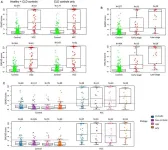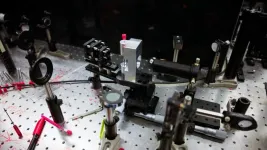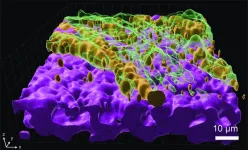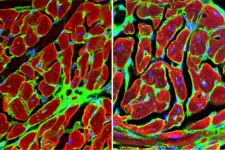(Press-News.org) The information environment in Finland during the coronavirus pandemic was exceptional and intense in many ways. The spread of disinformation and the number of actors involved reached unprecedented levels. The demand for accurate information was enormous, and the situation was constantly evolving. Information was disseminated through various channels. Official information played a crucial role, but at the same time, social media posed challenges in the fight against false and misleading information.
Malicious bots increased significantly during the pandemic. The operation of bots – i.e. programs imitating human users – was particularly aggressive during the key corona measures. These included, for example, the biggest information campaigns about corona vaccinations and instructions. This was evident in a study that analyzed a total of 1.7 million tweets related to the topic of COVID-19 on Twitter/X in Finland over the course of three years.
Bots accounted for 22 percent of the messages, while normally bots produce about 11 percent of the content in Twitter/X. Of the identified bot accounts, 36 percent (4,894) acted maliciously. In particular, they emphasized the unintentional dissemination of misinformation, i.e. incorrect information. About a quarter (approx. 460,000) of all messages contained incorrect information. Roughly the same proportion of messages expressed a negative attitude towards vaccines.
According to the study, malicious bots used the Finnish Institute for Health and Welfare's (THL) Twitter to intentionally spread disinformation, i.e. misleading information, but did not actually target THL. The bots increased the effectiveness and reach of their publications in different ways. For example, they mentioned other accounts in 94 percent of their tweets. The bots also proved to be adaptable; their messages varied according to the situation.
The study utilized the latest version of Botometer (4.0) to classify bot accounts, going beyond mere identification to differentiate between regular bots and COVID-19-specific malicious bots. This distinction is critical, as it reveals that traditional binary classifications of bots are insufficient.
“The findings highlight how regular bots often align with governmental messaging, enhancing their credibility and influence, while malicious bots employ more aggressive and deceptive tactics. The malicious bots may amplify false narratives, manipulate public opinion, and create confusion by blurring the line between credible and noncredible sources,” says Senior Researcher Ali Unlu, the primary author of the study.
Bot activity should be taken into account in public health communication
Malicious bots pose persistent threat even after the pandemic's peak. They continue to spread misinformation, particularly concerning vaccines, by exploiting public fears and skepticism.
The research suggests that these bots could have long-term implications for public trust in health institutions and highlights the importance of developing more sophisticated tools for detecting and mitigating the influence of such bots.
“Public health agencies need to enhance their monitoring and response strategies. Our study suggests that preemptive measures such as public education on bot activity and improved detection tools. The study also calls for more actions from social media platforms to curb clearly false information and account authenticity, which could significantly improve public trust and the effectiveness of public health communication,” says Lead Expert Tuukka Tammi from THL.
Non-English setting makes the research unique
Unlike most studies in this domain, which are predominantly in English, this research is one of the few that investigates social media bots in a non-English language, specifically Finnish. This unique focus allows for a detailed examination of external factors such as geographical dispersion and population diversity in Finland, providing valuable insights that are often overlooked in global studies.
“This study represents a significant contribution to understanding the complex role of bots in public health communication, particularly in the context of a global health crisis. It highlights the dual nature of bot activity — where regular bots can support public health efforts, while malicious bots pose a serious threat to public trust and the effectiveness of health messaging. The research provides a roadmap for future studies and public health strategies to combat the ongoing challenge of misinformation in the digital age,” concludes Professor of Practice Nitin Sawhney from Aalto University’s computer science department.
The study was conducted as part of the joint Crisis Narratives research project between Aalto University and THL, and was funded by the Research Council of Finland from 2020 to 2024.
END
Malicious social media bots increased significantly during the COVID-19 pandemic and continue to influence public health communication
2024-10-25
ELSE PRESS RELEASES FROM THIS DATE:
Sociodemographic factors associated with depression among people living with human immunodeficiency virus on antiretroviral therapy at a university teaching hospital in a Nigerian cosmopolitan city
2024-10-25
Background and objectives
Depression can lead to poor outcomes during antiretroviral therapy, and current evidence suggests high rates of depression among people living with human immunodeficiency virus (PLHIV), especially in low-and middle-income countries. This study was designed to investigate the sociodemographic factors associated with depression among PLHIV on antiretroviral therapy in a Nigerian cosmopolitan city.
Methods
A hospital-based, cross-sectional study was conducted among 592 consenting, ...
Surveillance imaging and GAAD/GALAD scores for detection of hepatocellular carcinoma in patients with chronic hepatitis
2024-10-25
Background and Aims
Early detection of hepatocellular carcinoma (HCC) is crucial for improving survival in patients with chronic hepatitis. The GALAD algorithm combines gender (biological sex), age, α-fetoprotein (AFP), Lens culinaris agglutinin-reactive fraction of AFP (AFP-L3), and protein induced by vitamin K absence or antagonist-II (PIVKA-II) for HCC detection. Similarly, the GAAD algorithm incorporates gender (biological sex), age, AFP, and PIVKA-II. This study aimed to assess the clinical utility of AFP-L3 in the GALAD algorithm and its potential synergies with ultrasound. We compared the clinical performance of GALAD with GAAD; AFP; AFP-L3; and PIVKA-II, with ...
Advanced liver fibrosis predicts liver outcomes in biopsy-proven metabolic dysfunction-associated steatotic liver disease
2024-10-25
Background and Aims
Data regarding risk factors and long-term outcomes of U.S. patients with biopsy-proven metabolic dysfunction-associated steatotic liver disease (MASLD) are limited. This study aimed to investigate the role of clinical and histologic risk factors on long-term outcomes in patients with MASLD.
Methods
A retrospective cohort study of 451 adults with biopsy-proven MASLD was conducted at a U.S. academic hospital from 2012 to 2020. An experienced pathologist evaluated the index liver biopsy. Patients with a prior liver transplant or alternative etiologies of chronic liver disease were excluded. The duration ...
A new spectroscopy reveals water’s quantum secrets
2024-10-25
Water is synonymous with life, but the dynamic, multifaceted interaction that brings H2O molecules together – the hydrogen bond – remains mysterious. Hydrogen bonds result when hydrogen and oxygen atoms between water molecules interact, sharing electronic charge in the process. This charge-sharing is a key feature of the three-dimensional ‘H-bond’ network that gives liquid water its unique properties, but quantum phenomena at the heart of such networks have thus far been understood only through theoretical simulations.
Now, researchers led by Sylvie Roke, head of the Laboratory for Fundamental BioPhotonics in EPFL’s School of Engineering, ...
Sliver of cool surface water helps the ocean absorb more carbon
2024-10-25
Subtle temperature differences at the ocean surface allow more carbon dioxide (CO₂) to be absorbed, new research shows.
Scientists studied the “ocean skin” – a sliver less than 2 mm deep at the ocean surface that is fractionally cooler than the rest.
Theoretical and lab work have suggested this temperature difference should increase the amount of CO₂ absorbed by the ocean – but this had never been successfully observed at sea before.
The new study – led by researchers from the University of Exeter’s Penryn Campus in Cornwall – used precision measurements to confirm that the ...
Study: Invasive silver carp reduce movement in Chicago-area water
2024-10-25
URBANA, Ill. — Invasive silver carp have been spreading throughout the Mississippi River Basin since their introduction a half-century ago. Yet, try as they might, the fish have not advanced beyond a particular stretch of the Illinois River north of Kankakee. Research from the University of Illinois Urbana-Champaign shows the fish are likely avoiding contaminants from the Chicago Area Waterway, which flows south before petering out around Kankakee.
A new study, published today in Scientific Reports, shows silver carp change their behavior and metabolism when introduced to water from the Illinois River north of Kankakee, representing Chicago-area water.
“When animals ...
A lung pathogen’s dilemma: infect or resist antibiotics?
2024-10-25
Imagine trying to settle into a new home while constantly being attacked. That’s what the bacterium Pseudomonas aeruginosa faces when it infects the lungs, and it can’t both spread and protect itself from antibiotics at the same time. Nonetheless, it’s one of the top culprits in hospital-acquired infections and it’s notorious for causing long-lasting, antibiotic-resistant infections, causing damage especially in people with lung diseases like cystic fibrosis, COPD, or bronchiectasis.
To survive tough conditions, P. aeruginosa forms colonies ...
Batteries for miniature bio-integrated devices and robotics — here’s how to do it
2024-10-25
University of Oxford researchers have made a significant step towards realising miniature, soft batteries for use in a variety of biomedical applications, including the defibrillation and pacing of heart tissues. The work has been published today in the journal Nature Chemical Engineering.
The development of tiny smart devices, smaller than a few cubic millimeters, demands equally small power sources. For minimally invasive biomedical devices that interact with biological tissues, these power sources must be fabricated from soft materials. Ideally, these should ...
UCLA researchers uncover novel role of protein GPNMB in heart repair
2024-10-25
FINDINGS
UCLA scientists have identified the protein GPNMB as a critical regulator in the heart’s healing process after a heart attack.
Using animal models, they demonstrate that bone marrow-derived immune cells called macrophages secrete GPNMB, which binds to the receptor GPR39, promoting heart repair. These findings offer a new understanding of how the heart heals itself and could lead to new treatments aimed at improving heart function and preventing the progression to heart failure.
BACKGROUND
Every 40 seconds, ...
Political polarization poses health risks, new analysis concludes
2024-10-25
News coverage of the 2024 election season has often centered on how partisan division has affected our politics. But a new analysis shows that political polarization also poses significant health risks—by obstructing the implementation of legislation and policies aimed at keeping Americans healthy, by discouraging individual action to address health needs, such as getting a flu shot, and by boosting the spread of misinformation that can reduce trust in health professionals.
“Compared to other high-income countries, the United States has a disadvantage when it comes to the health of its citizens,” ...





